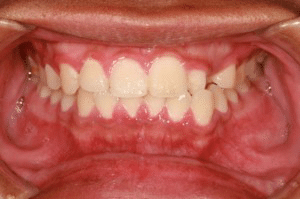
Treat Gum Disease Symtpoms & Root Cause of Peridontal Inflammation
Gum disease, also called periodontal disease is a chronic bacterial infection that affects the gums and the supporting teeth around them (see gum disease symptoms below). Gingivitis is a reversible gum inflammation condition that can lead into periodontal disease. Bacteria that are normally found in the mouth can spread under the gum line. When bacteria live under the gum line they may release toxins which cause uncomfortable and painful gum disease symptoms but will also eventually lead to gum tissue and bone destruction.
• Factors that may increase the risk of developing gum disease
Gum disease can be influenced by many factors. Hormonal changes during pregnancy and menopause can significantly add to oral health problems. Illnesses such as cancer, HIV, and diabetes, are also huge factors that may relate to gum disease and its severity. Gum disease can be made worse by medications such as Dilantin and Procardia. It can also be made worse by smoking. Good oral hygiene habits can minimize all of these factors from influencing gum disease.
• Signs and Symptoms of Gum Disease
Patients that have active gum disease will always have bleeding gums. The color of their gums will be more red than pink. They will also have a bad odor coming from their mouth which is the bacteria from the disease.
• Gum disease is a progressive process
Gum disease starts with toxins from bacteria that destroy hard and soft tissue around the teeth. It may be all over the mouth or it may be in a few spots. The gum tissue that attaches to the teeth gets disturbed and it breaks down. The natural pocket or space that exists around a tooth and the gum tissue is called a sulcus. This sulcus or space gets larger when gum disease occurs. This larger space is from gum tissue losing its connection to the tooth and the surrounding bone. As this attachment/connection loss gets more severe, the bone that holds the teeth in this area gets destroyed.
• How Is Gum Disease Detected?
Gum disease or periodontal disease is detected by your Dentist during your routine dental checkup. When you get your teeth cleaned, your dental hygienist will measure your gums with something called a periodontal probe which is a ruler made for the mouth. The measurements will show signs of health or disease. Your dentist will also look at your routine dental x-rays and look for bone loss which is the other sign for gum disease determination. The appearance of your gum tissue is also very significant in determining your gum health.
• Treatment Of Gum Disease
Once detected by your Dentist, gum disease must be treated to maintain the undamaged hard and soft tissue in the mouth. This simply means that the bone that gets destroyed cannot be put back but the remaining bone can be saved if action is taken immediately. The first step is non surgical scaling and root planning. This is a more advanced cleaning under your gums. A gum specialist may be needed if the nonsurgical approach does not work.
